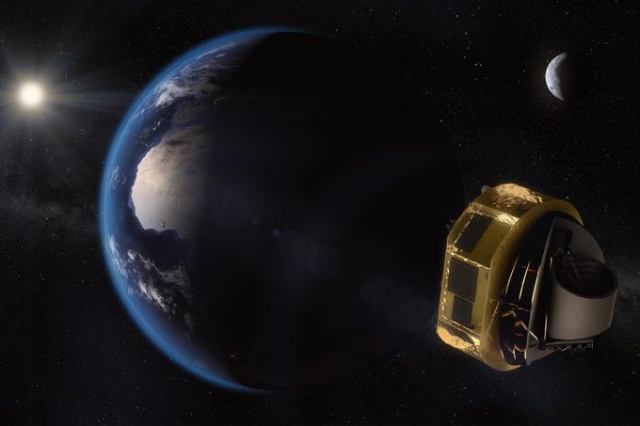ARIEL exoplanet mission selected as ESA’s next medium-class science mission
ARIEL, a mission to answer fundamental questions about how planetary systems form and evolve, has been selected by the European Space Agency (ESA) as its next medium-class science mission, due for launch in 2028. During a 4-year mission, ARIEL will observe 1000 planets orbiting distant stars and make the first large-scale survey of the chemistry of exoplanet atmospheres. ESA’s Science Programme Committee announced the selection of ARIEL from three candidate missions on 21 March, 2018.
26 March, 2018
The ARIEL mission has been developed by a consortium of more than 60 institutes from 15 ESA member state countries, including UK, France, Italy, Poland, Spain, the Netherlands, Belgium, Austria, Denmark, Ireland, Hungary, Sweden, Czech Republic, Germany, Portugal, with an additional contribution from NASA in the USA. UK institutions have provided the leadership and planning for ARIEL, including UCL, STFC RAL Space, STFC UK ATC, Cardiff University and the University of Oxford.
ARIEL’s Principal Investigator, Prof Giovanna Tinetti of UCL said, “Although we’ve now discovered around 3800 planets orbiting other stars, the nature of these exoplanets remains largely mysterious. ARIEL will study a statistically large sample of exoplanets to give us a truly representative picture of what these planets are like. This will enable us to answer questions about how the chemistry of a planet links to the environment in which it forms, and how its birth and evolution are affected by its parent star.”
ARIEL will study a diverse population of exoplanets ranging from Jupiter- and Neptune-size planets down to super-Earths, in a wide variety of environments. While some of the planets may be in the habitable zones of their stars, the main focus of the mission will be on warm and hot planets in orbits close to their star.
Warm and hot exoplanets represent a natural laboratory in which to study the chemistry and formation of planets. High temperatures keep different molecular species circulating throughout the atmosphere and prevent them from sinking or forming cloud layers, where they can become hidden from remote detection. The scorching temperatures experienced by planets close to their stars, which can be at temperatures in excess of 2000 degrees Celsius, also mean that more molecules from the planet’s interior make their way into the atmosphere. This provides ARIEL with better information about the planet’s internal composition and the formation history of the planetary system.
 Artist's impression of ARIEL on its way to Lagrange Point 2 (L2). Here, the spacecraft is shielded from the Sun and has a clear view of the whole sky.
Artist's impression of ARIEL on its way to Lagrange Point 2 (L2). Here, the spacecraft is shielded from the Sun and has a clear view of the whole sky. Image Credit: ESA/STFC RAL Space/UCL/Europlanet-Science Office
ARIEL will have a meter-class telescope primary mirror to collect visible and infrared light from distant star systems. A spectrometer will spread the light into a ‘rainbow’ and extract the chemical fingerprints of gases in the planets’ atmospheres, which become embedded in starlight when a planet passes in front or behind the star. A photometer and guidance system will capture information on the presence on clouds in the atmospheres of the exoplanets and will allow the spacecraft to point to the target star with high stability and precision.
The payload for ARIEL will be amongst the first to be assembled and tested at the STFC RAL Space National Satellite Test Facility, due to be open in mid-2020 following £99 million investment as part of the UK Government’s Industrial Strategy Challenge Fund.
 ARIEL will be placed in orbit around the Lagrange Point 2 (L2), a gravitational balance point 1.5 million kilometres beyond the Earth’s orbit around the Sun.
ARIEL will be placed in orbit around the Lagrange Point 2 (L2), a gravitational balance point 1.5 million kilometres beyond the Earth’s orbit around the Sun. Image Credit: ESA/STFC RAL Space/UCL/Europlanet-Science Office
ARIEL will be launched from Kourou in French Guiana and will be placed in orbit around the Lagrange Point 2 (L2), a gravitational balance point 1.5 million kilometres beyond the Earth’s orbit around the Sun. Here, the spacecraft is shielded from the Sun and has a clear view of the whole sky to maximise the possible target exoplanets for observations.
The ARIEL Consortium Project Manager, Paul Eccleston, of STFC RAL Space said “It is wonderful news that ESA have selected ARIEL for the next medium class science mission. The team are very excited to have the opportunity to realise the mission we’ve been developing for the last two years. ARIEL will revolutionise our understanding of how planetary systems form and evolve, helping us put our own solar system into context and compare it to our neighbours in the galaxy.”
ARIEL (Atmospheric Remote-Sensing Infrared Exoplanet Large-survey) Facts and Figures
Elliptical primary mirror: 1.1 x 0.7 metres
Instrumentation: 3 photometric channels and 3 low resolution spectrometers covering from 0.5 to 7.8 microns in wavelength.
Mission lifetime: 4 years in orbit
Launch date: 2027 or 2028
Payload mass: ~450 kg
Total Spacecraft Dry mass: ~1200 kg
Launch mass: ~1300kg
Destination: Sun – Earth Lagrange Point 2 (L2)
ESA Mission Cost: ~450 million Euros, plus nationally funded contribution of the payload
Launch vehicle: Ariane 6-2 from French Guiana
For further information on ARIEL see: http://ariel-spacemission.eu
Science contact
Prof Giovanna Tinetti
University College London
Mob: +44 (0)7912509617
Technical contact
Paul Eccleston
STFC RAL Space
Mob: +44 (0)7500571666
Media contacts
Anita Heward
Press Officer, ARIEL
Mob: +44 (0)7756 034 243
Madeleine Russell
Communications Officer, RAL Space
Tel: +44 (0) 1235 446288
Dr Rebecca Caygill
Media Relations Manager
UCL Communications & Marketing
Tel: +44 (0)20 3108 3846
Mob: +44 (0)77 3330 7596
Michael Bishop
Senior Communications Officer
Cardiff University
Tel: 02920 874499
Mob: 07713 325300
